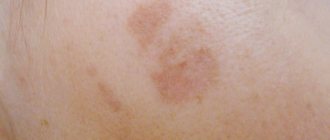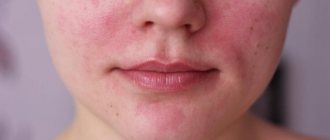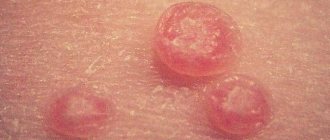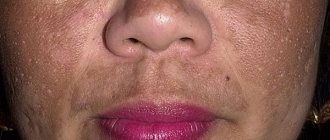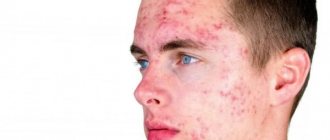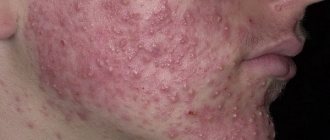Causes
The main causes of injury to the interdigital space are mechanical damage due to improper care and fungal infections (mycoses). Provoking factors for the development of cracks in the feet are:
- uncomfortable shoes made from low-quality materials;
- long-term wearing of open shoes (exposure to dust, dry air, mechanical irritation, especially from flip-flops);
- long-term use of hosiery made of synthetic materials;
- non-compliance with the rules of personal foot hygiene;
- neglect of cosmetic care;
- walking barefoot;
- visiting public places;
- high load on the legs (teachers, salespeople, doctors, athletes).
- Infection with foot fungus occurs due to a combination of non-compliance with personal hygiene rules and microtraumas of the skin between the toes.
Also, why the skin of the feet cracks can be explained by the presence of such pathological conditions of the body as: dyshidrosis of the feet;
- deficiency of vitamins A, E and B;
- pathology of the endocrine system (obesity, diabetes, thyroid disease);
- bacterial infection;
- pathology of the vessels of the lower extremities (impaired blood supply due to damage to the arteries or blood outflow due to varicose veins);
- allergies (atopic dermatitis, eczema, neurodermatitis);
- plantar psoriasis;
- keratoderma.
Before treating a crack between your toes, the exact cause should be determined. Sometimes you cannot do without medical help; this applies to injuries that are long-term non-healing and resistant to therapy.
What type of treatment do you prefer?
- "Radevit";
- "Carmol";
- "Nutraderm";
- "Allga San".
Regular Vaseline and glycerin are good for especially dry skin. Shostakovsky ointment has an excellent healing effect in the treatment of cracked legs. Allergy sufferers are often recommended the Zorka cream; it is almost completely natural and does not contain any fragrances. Diabetics are prescribed SixtuMed foot bath oil to treat cracked feet. For disorders caused by the body's endocrine system, hormones are additionally prescribed.
Symptoms
Symptoms of skin damage between the toes may vary depending on the cause that caused them. So, with dyshidrosis it is noted:
- increased sweating of the feet;
- diaper rash and maceration;
- redness;
- burning at the site of injury;
- spread of the process to neighboring areas.
Article for you:
Cardiac arrhythmia, what it is and how to treat it
In case of fungal infections, the clinical picture of the lesion is characterized by the following signs:
- a dry area forms at the site of the lesion;
- itching, and as a consequence the presence of scratching;
- the appearance of one or more bubbles that burst;
- formation of erosions, peeling;
- with candidiasis there may be a white coating;
- unpleasant odor;
- damage to the nails (they become yellow, thickened, and crumble easily).
With bacterial inflammation between the fingers, the presence of such characteristic symptoms as:
- bright redness;
- soreness;
- swelling;
- increase in local temperature;
- there may be purulent discharge.
When affected by allergic origin, keratoderma or psoriasis, the cracks are deep, occur against the background of severe hyperkeratosis (excessive keratinization of the epidermis), may be accompanied by itching, the skin peels off in layers, and the affected areas may bleed.
For additional diagnostics, a dermatologist may prescribe a culture of a scraping from the skin separated from a crack, perform a biopsy of a small area for histological examination, and schedule a consultation with a related specialist.
Preventive measures
According to doctors, often bursting wounds and peeling on the feet occur in people who ignore simple rules of foot hygiene - many pay insufficient attention to these parts of the body.
Meanwhile, thoroughly washing your feet at least twice a day will help avoid unpleasant symptoms. Massage, especially using olive or lavender oil, has a beneficial effect on foot health. If you follow a proper diet and after giving up all bad habits, positive changes can be noticed not only in the improved condition of your legs, but also in your general well-being. To prevent your skin from drying out, you need to take care of its hydration. To do this, you need to drink at least 1.2-2 liters of water per day.
Shoes should be worn that are comfortable, fit properly and preferably made from natural materials. Women should not wear high-heeled shoes or boots too often. After all, they provoke the formation of microcracks in the fingers and are often the cause of foot deformation.
General recommendations
The health of your feet largely depends on the quality of foot care and the correct selection of shoes. In order to quickly and effectively cure cracks, as well as to prevent their recurrence, it is important to follow the following recommendations:
- wash your feet daily (in the evening) with soap and then apply a caring cream;
- selection of high-quality shoes based on size, last comfort, heel height;
- restriction of wearing open shoes;
- in public places (swimming pools, baths, saunas, gyms) use individual replacement shoes;
- take foot baths with cosmetics twice a week, use foot belongings;
- exclude long-term wearing of nylon and synthetic hosiery;
- If possible, perform a professional pedicure at least once a month;
- if necessary, use compression stockings;
- Carry out daily gymnastics and self-massage of the feet;
- control blood sugar levels;
- include in your diet foods rich in vitamins A, B, E (cereals, cereals, eggs, liver, sea fish, herbs, vegetable oils).
Article for you:
How to treat hangnails on fingers at home
In most cases, following these recommendations will effectively combat dryness, excessive sweating, and unpleasant foot odor. Compliance with simple rules of hygienic care for the skin of the feet becomes a favorable basis for drug treatment if necessary.
Traditional methods of treatment
Traditional methods of treating this disease can be quite effective and are not inferior to drugs from the pharmacy. If the skin separation was initiated by a fungus, it is better to refrain from self-treatment at home. If the cracks have arisen for completely harmless reasons, you can safely begin treatment with herbs and homemade ointments. There are many ways to get rid of the unpleasant manifestations of dry skin: make foot baths, lotions, wraps, apply ointments. Each method is effective in its own way and helps to cope with the problem.
Several ways to get rid of cracked legs at home:
Soda and salt
Soda and salt should be diluted in hot water and your feet should be steamed in it. The proportions are as follows: 1 tsp. soda and salt per liter of water. You need to do the procedure daily, and steam your feet for at least half an hour.
Decoction of medicinal herbs
To treat cracked legs, chamomile flowers and herbs such as celandine, string and plantain are usually used. Oak bark is good for the skin. Calendula is an excellent wound healing agent with an anti-inflammatory effect. Collections of the listed medicinal herbs will help cope with cracked legs. All you need is to prepare a bath for foot treatments with the addition of a decoction of herbs and steam your feet in it.
Applying lotions
Treat cracked feet with honey, applying it at night. For an additional effect, put warm socks on your feet.
A mixture of rolled oats and olive oil helps with dry skin on the feet. The flakes are poured with boiling water and allowed to brew, after which olive oil is added. Apply the mixture to the cracks formed and cover with cling film on top. The duration of this procedure is two hours.
Coniferous oil will be a real godsend for treating dry skin on your feet. To do this, keep the spruce needles in a water bath for two hours (the proportions of water and pine needles are the same - 50 to 50), then add 1 tsp. camphor and 1. tbsp. l. butter. It is necessary to lubricate cracked feet with pine oil daily.
In conclusion, it is worth recalling that timely preventive measures and correct diagnosis will help stop negative consequences. If treated improperly and untimely, foot fungus can result in complications in the form of an intertriginous or dyshidrotic form. If unpleasant symptoms occur in the form of peeling skin, dryness and cracks on the legs, you should consult a doctor to determine the cause of external defects.
Drug therapy
Treatment of cracks between the toes, if the causes of the damage are not due to defects in care, should be carried out with the help of medications.
In this situation, local therapy with soft forms, powders, and liquids is most acceptable. For fungal foot infections, ointments and creams containing an antimycotic can be used:
- Lamisil (386-861r).
- Terbinafine (56-149r).
- Pimafucin (235-538r).
- Nizoral (RUR 340-633).
- Mikoderil (297-635 rubles).
In case of damage of bacterial origin, products containing antibacterial substances can be used:
- Levomekol (81-113r).
- Oflomelid (97-140r).
- Levosin (69-98r).
- Baneocin (224-377r).
- Drapolene (201-282r).
Antiseptic solutions are used to treat the skin:
- Chlorhexidine (9-39r).
- Furacilin (36-61r).
- Betadine (148-380r).
- Miramistin (131-316r).
- Octenisept (214-300r).
In complex therapy for skin damage between the fingers, drugs that promote rapid healing and tissue renewal can be used, such as:
- Bepaten (268-641r).
- Solcoseryl (149-210r).
- Methyluracil (42-60r).
- Radevit Active (295-439 rubles).
- Pantoderm (167-237r).
For cracks of allergic origin, psoriasis and keratoderma, therapy with ointments containing glucocorticoids may be required:
- Avecort (188-264 rubles).
- Beloderm (175-255r).
- Cutivate (204-307r).
- Fluorocort (138-193r).
- Elokom (334-474r).
Antibacterial and hormonal agents should be prescribed by a doctor after excluding other pathologies. If the integrity of the skin is damaged due to impaired blood supply or diabetes mellitus, treatment should be comprehensive, aimed at stabilizing the underlying disease. Self-medication in this case is not allowed.
How to treat diabetic fissures?
In people who suffer from diabetes, the skin cracks more often. But it is very important for them to monitor the integrity of the epidermis, because their immunity is weakened, and infection can lead to deterioration in health.
In medicine, healing ointments created specifically for diabetics are used. Before applying them, it is recommended to take baths for the lower extremities so that the epidermis becomes soft, and then remove dead cells with a scrub.
It is forbidden to treat the skin on the feet with a pedicure blade and take baths with too hot water.
The effect of dry skin on the appearance of cracks
If the skin on your big toe or anywhere else is cracking, you need to take care of more intense hydration of the body. To do this, you can use oils, special gels, creams or sprays. Indeed, with increased dryness of the skin, its elasticity decreases and any movement can lead to micro-tears, which gradually increase.
The feet receive quite a lot of load during the day, so damage often appears on their surface or between the toes, making it difficult to move freely and painlessly. The manifestation of defects should not be neglected , because they may indicate not only the impact of an unfavorable external environment, but also dysfunction of internal organs. Therefore, it is necessary to undergo examination by a doctor and select a treatment method.
